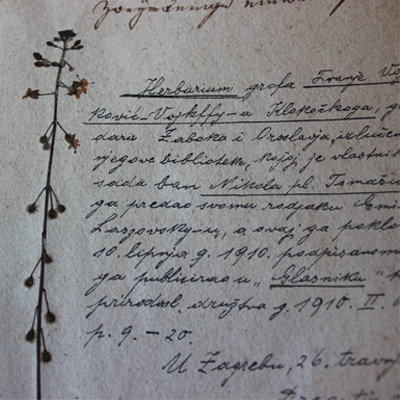History
The Division of Botany (Department of Biology, Faculty of Science, University of Zagreb) holds two officially registered University herbarium collections: Herbarium Croaticum (ZA), and Ivo and Marija Horvat herbarium (ZAHO). These are the two oldest and largest collections in Croatia. The first collection holds herbarium specimens collected by various researchers during the past 200 years, while the second collection is the fruit of lifetime labour of Professor Ivo Horvat and his spouse Marija.
Herbarium Croaticum (ZA) collection was founded in 1880 (although the oldest specimens date back to 1820), and nowadays represents the oldest and largest herbarium in Croatia. Historically, this collection represents continuous botanical activity since the times of Illyrian revival when, even before the founding of the National Museum in Zagreb in 1846, a substantial quantity of botanical material was already collected, based on the herbarium of Josip Host. After the founding of the National Museum, this botanical collection was supplemented by the herbarium of Hugo von Klinggräff, later to be expanded by collections of numerous researchers: most noteworthy being Josip Schlosser, Ljudevit Vukotinović, Mato Vodopić, Franz Petter, Antun Pavić, Slavoljub Wormastiný, Augustin Grubišić, Matija Botteri, Ana Maria Smith, Elise Braig, Maria de Cattani, and Josip Pančić.
Upon the founding of the University and the appointment of Bohuslav Jiruš as the first professor of botany in 1875, Spiridion Brusina initiated a transfer of the ownership of the National Museum’s herbarium collection to the Department of Botany and Physiology (at present: Division of Botany, Faculty of Science), which was approved by the Government. The National Museum’s herbarium and the herbarium of prof. Jiruš together formed the collection marked as the starting point of the Herbarium Croaticum, established in 1880, at time holding approximately 25,000 herbarium specimens. At first, the Division of Botany and Physiology and the collection were housed in Gornjogradska Gymnasium in Zagreb. In 1882 they were relocated to the present-day Senate building. Later on, in 1920 the collection was moved to the building at Marko Marulić Square 20, where it remains to present day.
Herbarium Croaticum (ZA) collection was founded in 1880 (although the oldest specimens date back to 1820), and nowadays represents the oldest and largest herbarium in Croatia. Historically, this collection represents continuous botanical activity since the times of Illyrian revival when, even before the founding of the National Museum in Zagreb in 1846, a substantial quantity of botanical material was already collected, based on the herbarium of Josip Host.
Since their establishment, the collections within the Herbarium Croaticum were organised into main organisational collections: Herbarium Generale, Herbarium Croaticum sensu stricto and Herbarium Cryptogamicum (algae, fungi, lichens). The largest part of the Jiruš collection, with about 10,000 specimens, is deposited within the Herbarium Generale together with Herbarium generale Rossianum with approximately 4,000 specimens. Within the same Herbarium there are also numerous smaller collections received by donations and through exchange, containing some interesting specimens from around the world. Regarding Croatian flora, the most important collections from the perspective of quantity and value are: Herbarium Croaticum Rossianum with approx. 30,000 specimens, collected by the distinguished Croatian botanist Ljudevit Rossi throughout Croatia, but mainly in the vicinity of Karlovac, Lika, Velebit and Croatian littoral area; Herbarium Croaticum Hircianum with approx. 12,000 specimens collected by Dragutin Hirc, the most productive Croatian nature writer, and Herbarium Haračić with approx. 8,000 specimens collected by Ambroz Haračić from Kvarner region, mainly from the Island of Lošinj. During the time, the collection was located in the Senate building and the contribution to the collection was also given by Antun Heinz, Stjepan Gjurašin and Aurel Forenbacher. After the relocation to Marko Marulić Square, the collection continued to grow steadily thanks to the contribution of generations of national and a few international researchers, most notably Vale Vouk, Ivo Horvat (material not included in personal collection; ZAHO), Stjepan Horvatić, Karlo Bošnjak, Ivan Soklić, Josip Linardić, Ante Ercegović, Fran Kušan, Stjepan Urban, Zora Klas, Ivo Pevalek, Zlatko Pavletić, Bogdan Korica, Radovan Domac, Ljerka Marković, Ljudevit Ilijanić, Marija Bedalov, Nedeljka Šegulja, Ivan Šugar, and Miško Plazibat.
The Herbarium of Ivo and Marija Horvat (ZAHO) was established in 1918 and contains 71,611 specimens, mainly of vascular plants collected in Croatia, but also from other Balkan and European countries. The collection presents the lifetime of productive work of one of Croatia’s most prominent botanists, Professor Ivo Horvat. The collection was at first located at the Faculty of Veterinary Medicine where prof. Horvat was employed from 1943 to 1963. Eventually, it was moved to the premises of the former Yugoslav (present day: Croatian) Academy of Sciences and Arts and finally in 1998 it was relocated to Marko Marulić Square 9a. Several type specimens of species discovered by Prof. Horvat are kept within the collection, including some herbarium specimens which are still not officially typified according to the current standards of the Botanical Nomenclature Codex.
The Herbarium of Ivo and Marija Horvat (ZAHO) was established in 1918 and contains approximately 78,000 specimens, mainly of vascular plants collected in Croatia, but also from other Balkan and European countries.

